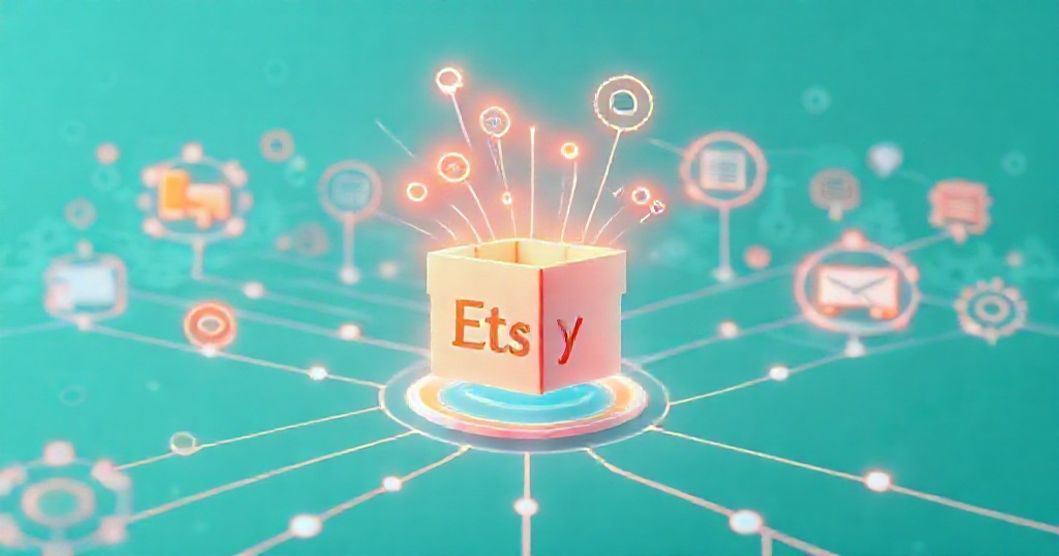In the dynamic landscape of online retail, managing an Etsy shop efficiently requires more than just creating beautiful products. Sellers often face challenges in streamlining various operational aspects, from inventory tracking to shipping and accounting. This is where the power of Etsy integrations becomes indispensable. These technological bridges connect your Etsy store with external tools and services, automating mundane tasks and significantly enhancing productivity. By strategically implementing Etsy integrations, sellers can free up valuable time, reduce manual errors, and focus on what they do best: creating and selling unique items to a global audience.
Understanding Etsy Integrations: What They Are and Why They Matter
Etsy integrations are third-party applications or software solutions designed to seamlessly connect with your Etsy shop’s data and functionalities. They act as extensions, allowing information to flow between Etsy and other platforms, thereby automating repetitive processes. The primary goal of these integrations is to simplify complex tasks, improve data accuracy, and provide a holistic view of your business operations. For any Etsy seller looking to scale their business, understanding and utilizing these tools is crucial for long-term sustainability and growth.
Types of Etsy Integrations: Key Categories for Sellers
The marketplace offers a diverse ecosystem of tools tailored to various seller needs. Identifying the right types of Etsy integrations can profoundly impact a business’s operational efficiency and profitability. Each category addresses specific challenges, ensuring that every facet of your selling journey is optimized for peak performance. Understanding these distinctions helps sellers make informed decisions about which solutions best fit their unique business model and growth objectives.
Inventory Management Integrations for Seamless Stock Control
Effective inventory management is paramount for any retail business, especially for unique or handmade items on Etsy. Integrations specializing in inventory control automatically synchronize stock levels across your Etsy shop and any other sales channels you utilize. This prevents overselling, reduces manual counting errors, and ensures customers always see accurate product availability. Tools in this category can track raw materials, finished goods, and even bundle components, providing a clear picture of your stock at all times.
Shipping and Fulfillment Integrations for Efficient Delivery
Shipping is a critical component of customer satisfaction and overall operational cost. Etsy integrations focused on shipping and fulfillment automate label generation, calculate shipping costs, and provide real-time tracking updates. These tools often integrate with various carriers, allowing sellers to compare rates and choose the most cost-effective options. By streamlining the fulfillment process, sellers can reduce handling time, minimize errors, and improve the overall delivery experience for their customers, leading to higher satisfaction rates.
Accounting and Bookkeeping Integrations for Financial Clarity
Managing finances accurately is essential for legal compliance and strategic decision-making. Accounting and bookkeeping Etsy integrations automatically pull sales data, expenses, and transaction fees directly from your shop into your preferred financial software. This eliminates the need for manual data entry, reduces the risk of human error, and provides an up-to-date overview of your business’s financial health. Such integrations are invaluable for tax preparation, profit analysis, and budgeting for future growth.
Marketing and Email Automation Integrations for Customer Engagement
Building a loyal customer base requires consistent engagement and targeted communication. Marketing and email automation Etsy integrations help sellers connect with their audience more effectively. These tools can capture customer email addresses, segment audiences based on purchase history, and automate promotional campaigns or abandoned cart reminders. By personalizing interactions and nurturing leads, sellers can drive repeat purchases and foster stronger relationships with their customer base, enhancing brand loyalty.
Print-on-Demand (POD) Integrations for Custom Product Expansion
For sellers offering custom designs or varied product lines without holding physical inventory, Print-on-Demand (POD) integrations are transformative. These Etsy integrations connect your shop directly to POD service providers, automating the production and shipping of items only after an order is placed. This model allows sellers to offer a vast array of products, such as apparel, home decor, or accessories, without upfront investment in stock. POD integrations streamline the entire process from order to delivery, enabling business expansion with minimal risk.
Choosing the Right Etsy Integrations: Factors to Consider
Selecting the appropriate Etsy integrations is a strategic decision that can significantly impact your business’s trajectory. Several factors should guide your choices to ensure that the tools you adopt genuinely enhance your operations and contribute to your growth rather than creating additional complexity. A thoughtful approach to evaluating potential integrations will prevent unnecessary expenses and ensure a smoother workflow for your Etsy shop.
Assess Your Business Size and Scale Requirements
The size and growth stage of your Etsy shop should heavily influence your integration choices. A new seller might prioritize basic shipping and inventory tools, while a high-volume business might need comprehensive enterprise-level solutions. Consider your current order volume, product diversity, and future expansion plans when evaluating options. Scalable Etsy integrations ensure that the tools can grow with your business, avoiding the need for frequent overhauls.
Evaluate Product Types and Operational Complexity
The nature of your products—whether they are handmade, vintage, digital, or print-on-demand—determines specific integration needs. For instance, sellers of personalized items will benefit from integrations that streamline customization requests, while those selling digital downloads might focus on tools for automated delivery. Understand the unique complexities of your product lines to select Etsy integrations that truly address your operational challenges.
Consider Budget and Cost-Effectiveness of Solutions
Etsy integrations come with various pricing models, from free tiers to monthly subscriptions or transaction-based fees. It is crucial to evaluate the long-term cost-effectiveness of each solution relative to the benefits it provides. While some integrations might have a higher initial cost, the time savings and error reduction they offer could lead to significant profitability gains. Always compare features against pricing to ensure a worthwhile investment for your business.
Prioritize Ease of Use and Learning Curve
The most powerful integration is only effective if you and your team can use it efficiently. Look for Etsy integrations with intuitive interfaces and clear documentation. A steep learning curve can negate the benefits of automation, leading to frustration and wasted time. Many providers offer free trials, which are excellent opportunities to test the user experience and assess how well the integration fits into your existing workflow.
Implementing Etsy Integrations: Best Practices for Sellers
Successfully integrating new tools into your Etsy business requires a thoughtful approach beyond just selecting the right software. Proper implementation ensures that these new systems genuinely enhance your operations without introducing unforeseen complications. Adhering to best practices will help you maximize the benefits of Etsy integrations, maintain data integrity, and ensure a seamless transition for your workflow. A strategic rollout is key to leveraging technology for sustained success.
Start Small and Scale Up Gradually
When introducing new Etsy integrations, it is often best to adopt a phased approach. Begin with one or two critical integrations that address your most pressing pain points, such as shipping or inventory. Once these are smoothly operational, gradually introduce additional tools. This method allows you to master each integration, understand its impact on your workflow, and troubleshoot issues without overwhelming your system or team with too many changes at once, ensuring a stable transition.
Prioritize Data Security and Privacy Measures
Connecting third-party tools to your Etsy shop involves sharing sensitive business and customer data. Always prioritize integrations that demonstrate robust data security protocols and comply with relevant privacy regulations. Review the privacy policies of any potential integration partner carefully. Ensuring the security of your information is paramount to protecting your business reputation and maintaining customer trust, making it a non-negotiable aspect of your selection process.
Conduct Regular Monitoring and Review of Performance
Implementing Etsy integrations is not a one-time task; it requires ongoing attention. Regularly monitor the performance of your integrated tools to ensure they are functioning as expected and delivering the promised benefits. Look for any discrepancies in data, errors in automation, or areas where optimization might be possible. Periodic reviews allow you to adapt to changes in your business needs or the integration’s features, ensuring continued efficiency.
Invest in Training and Utilize Available Support
To fully leverage the capabilities of your Etsy integrations, ensure that you and any team members who will use them are adequately trained. Most integration providers offer tutorials, knowledge bases, and customer support. Do not hesitate to utilize these resources. Proper training minimizes user errors, increases efficiency, and helps you unlock the full potential of the tools. Investing time in learning is an investment in your business’s operational excellence.
Maximizing Profitability with Strategic Etsy Integrations
Strategic adoption of Etsy integrations directly translates into tangible profitability gains for your business. By automating time-consuming tasks, reducing manual errors, and optimizing various operational areas, these tools contribute significantly to your bottom line. The efficiency improvements allow sellers to allocate more time to product development, marketing, and customer service, which are direct drivers of revenue. Ultimately, integrations empower sellers to manage their business more effectively, leading to increased sales and higher profit margins in the competitive online marketplace.
Conclusion
The journey of growing an Etsy business is continuously evolving, and strategic use of Etsy integrations is a cornerstone for sustained success. By carefully selecting and implementing tools for inventory, shipping, accounting, marketing, and print-on-demand, sellers can transform their operational efficiency. These integrations not only save valuable time and reduce errors but also provide critical insights that drive informed decisions. Embracing the power of integrations allows Etsy sellers to streamline their workflow, enhance customer satisfaction, and ultimately foster remarkable business growth in a competitive digital landscape.






